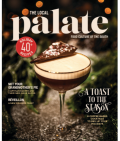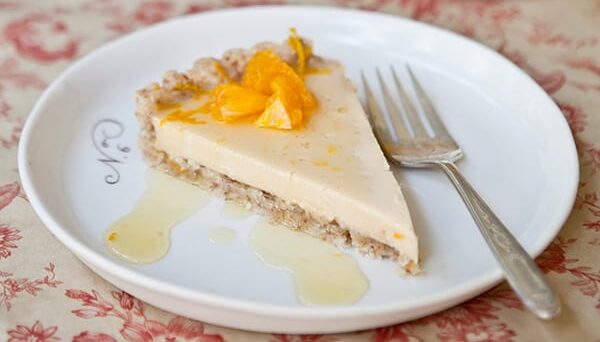Garnished with orange rinds, the caramel cream pie by James Beard award winning author Nathalie Dupree is detailed with a pecan crust.
recipe 
yields
1 9-inch pie
1 pecan crust, prepared through prebaking (recipe follows)
¼ cup granulated sugar
1 cup water
2¼ cups heavy cream, divided
1 packaged powdered gelatin
Grated orange rind, for garnish (optional)
½ cup plus 2 tablespoons unsalted butter, room temperature
½ cup granulated sugar
1⅓ – 1½ cups all purpose flour, preferably soft-wheat
¼ teaspoon salt
1¼ cups chopped pecans, divided
Caramel Cream Pie
Pecan Crust
steps
- Preheat oven to 375 degrees.
- Heat sugar with water in a heavy pan over low heat without boiling until sugar is dissolved. Turn up the heat, bring to the boil, and boil until the water is greatly evaporated and the syrup is making large bubbles. Watch carefully as it turns deep amber, taking care it doesn’t burn.
- Cover hands with a towel or oven mitt and tip the pan to see how deep the color is in the thickest part of the pan. If it is too pale, the dessert will not be flavored sufficiently. When a deep amber color is achieved, cool slightly. (Do not let the syrup harden.) Cover hands again with towel or oven mitt and add 1 cup heavy cream to the mixture. It may bubble up. Stir well. If the mixture seems uneven, put back over the heat, stirring to mix the cream and caramel thoroughly. It should be uniform in color.
- Meanwhile, add ¼ cup cream to a small pot or metal measuring cup. Sprinkle the gelatin on top and stir lightly to make sure it is distributed. After the gelatin becomes absorbed into the cream and thickens, heat gently until melted with no granules remaining. Do not boil.
- Stir gelatin into the warm caramel mixture, followed by the remaining cup of cream, making sure there are no lumps of gelatin and that the caramel is evenly distributed throughout. Refrigerate 10−15 minutes. When cool but not set, stir and gently pour into the piecrust. Refrigerate at least 30 minutes or until set.
- When ready to serve, remove the tart by putting the pan on top of a large jar and pulling down the exterior ring of the pan. If the tart sticks, run a knife around the inside of the ring. Garnish with orange rind.
Pecan Crust
- Beat the butter and sugar together until light using a food processor or electric hand mixer. Sift the flour with the salt onto a piece of waxed paper.
- Chop half the pecans more finely, keeping them larger than a crumb. Add both the finely chopped and roughly chopped pecans to the flour mixture. Pulse once or stir this into the butter-sugar mixture, pulling it all together to make the dough. Shape into a round and flatten.
- Place between two pieces of plastic wrap or in a large plastic bag. Roll out into a ⅛-inch-thick round of approximately 11 inches. (If the dough is sticking miserably, add some flour and start again. Extra handling will not hurt this short crust dough.)
- Chill the dough 30 minutes or until firm. (It may be refrigerated several days or frozen.) If using a tart pan with a removable bottom, surround the bottom of the pan with foil to prevent the filling from leaking out while baking.
- Preheat oven to 350 degrees.
- Remove the top sheet of plastic wrap or slit the bag and flip the dough into a 9-inch tart pan. Push the dough onto the sides of the pan, pushing together any cracked places in the dough. Check carefully to see if there are any holes; if so, patch them. Save any leftover dough for patching later if necessary. Chill another 30 minutes.
- Move the pan to a rimmed baking sheet and bake 10 minutes. Remove when still soft and pastry has turned light brown. There should be just a faint scent of cooking pecans in the air; more than that indicates the crust is overcooked. Check for cracks and patch if necessary with the leftover dough. The crust may be made ahead to this point, kept a day or two at room temperature, or frozen up to 3 months, carefully wrapped.
Note: Leftover dough can be cut into small shapes and baked as cookies.
share
- from chef and author Nathalie Dupree, Charleston, South Carolina






